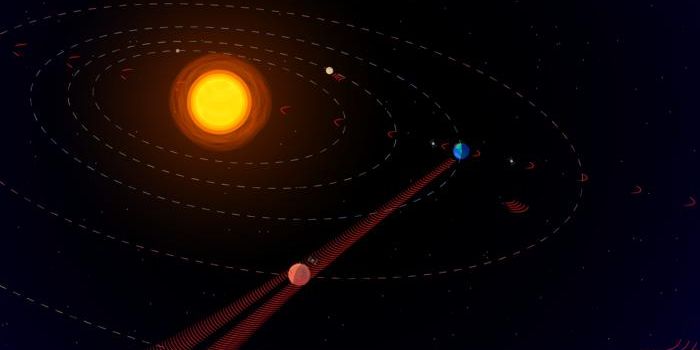The Mystery of the Blue Ring Nebula is Solved
In 2004, the Blue Ring Nebula was first identified. It appeared as a faint gas blob with a star at its center and was unlike anything else in the Milky Way. Scientists could not understand what it was. It was observed over the years with a variety of instruments including telescopes on Earth and in space. Reporting in Nature, scientists have now revealed more about what it is.
Stars in the Milky Way are often found in pairs that orbit one another. When they are close, they may eventually collide in a merger as they get older and grow larger. When two stars collide material is rapidly ejected away. from the collision. Researchers wondered if that might be how the Blue Ring Nebula was formed.
"We were in the middle of observing one night, with a new spectrograph that we had recently built, when we received a message from our colleagues about a peculiar object composed of a nebulous gas expanding rapidly away from a central star," said Princeton University's Guðmundur Stefánsson, the Henry Norris Russell Postdoctoral Fellow in astrophysical sciences. "How did it form? What are the properties of the central star? We were immediately excited to help solve the mystery!"
For this work, the researchers decided to use different spectrographs on Earth-based telescopes: the HIRES optical spectrograph on the 10-meter Keck Telescope at Maunakea in Hawaii, and the near-infrared Habitable-zone Planet Finder on the 10-meter Hobby-Eberly Telescope at McDonald Observatory in Texas.
"The spectroscopic observations were key in allowing us to understand the object further, from which we see that the central star is inflated, and we see signatures of accretion likely from a surrounding disk of debris," Stefánsson said.
"Indeed, the spectroscopic data coupled with theoretical modeling shows that the Blue Ring Nebula is consistent with the picture of a merging binary star system, suggesting that the inwards spiraling companion was likely a low-mass star," explained lead study author Keri Hoadley, a postdoctoral fellow at Caltech.
While the relics of star mergers have been seen before, they are typically obscured by clouds of dust, and the stellar remnant can't be observed. The Blue Ring Nebula is different, however, and provides a clear picture of the merger's leftovers. It can help researchers learn more about the merging process.
"The Blue Ring Nebula is rare," said Hoadley. "As such, it is really exciting that we were able to find it, and we are excited about the possibility of finding more such objects in the future. If so, that would allow us to gain further insights into the remnants of stellar mergers and the processes that govern them."
The authors noted that one telescope they used is located at the summit of Maunakea in Hawaii, which has very important cultural significance for the indigenous Hawaiian community. "We are most fortunate to have the opportunity to conduct observations from this mountain," they said. Learn more from Nature about why the construction of a new telescope at the site is being protested.
Sources: AAAS/Eurekalert! via Princeton University, W.M. Keck Observatory, Nature









